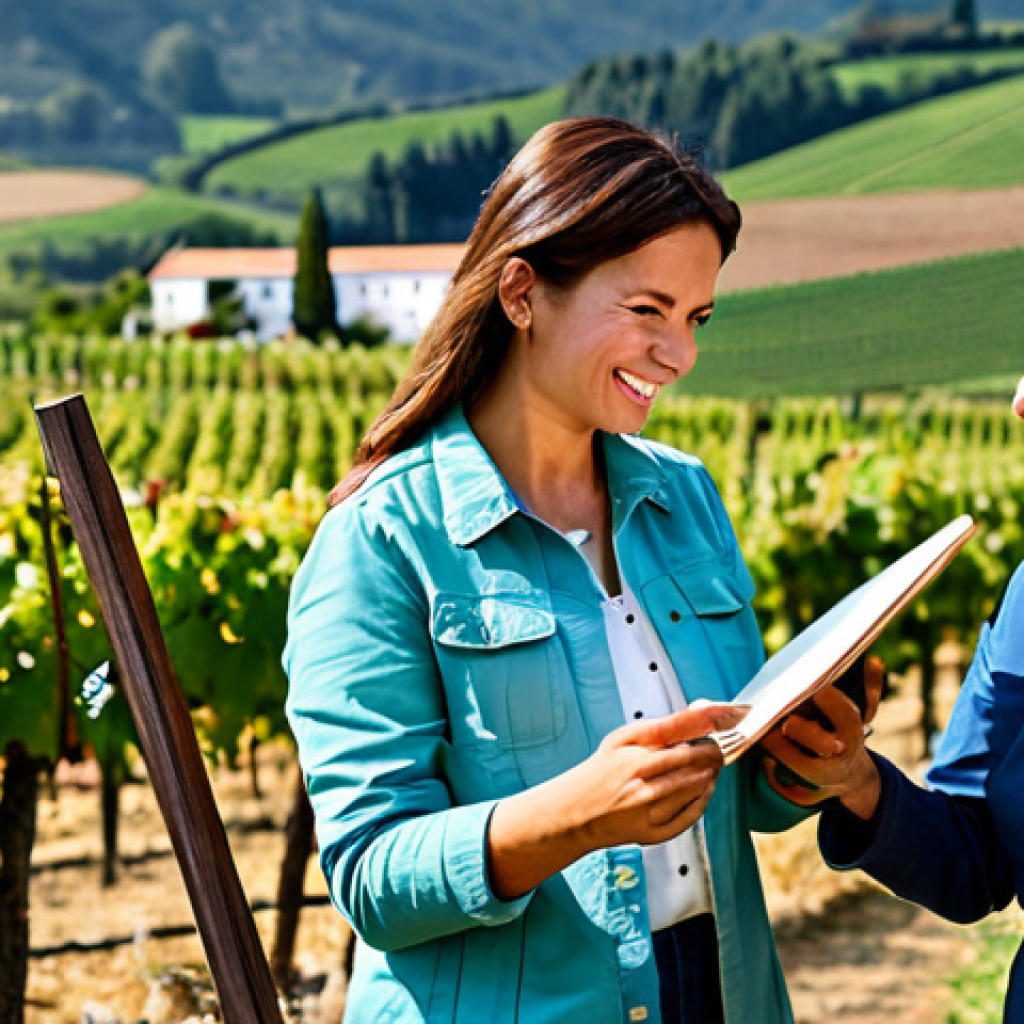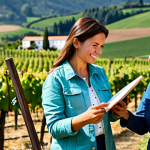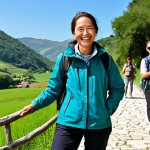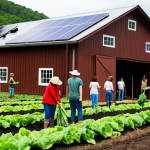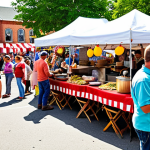Have you ever wondered what truly makes a rural getaway unforgettable? It’s more than just picturesque scenery or quaint accommodations; from my own adventures, I’ve consistently found that the magic truly happens when there’s someone passionate guiding the way.
A skilled rural tourism guide isn’t merely a tour leader; they are the heart and soul connecting visitors to the land, its people, and its unique stories.
What I’ve personally seen is a dramatic shift in what travelers seek. Gone are the days when a simple sightseeing itinerary sufficed. Today, people are craving authentic, immersive experiences – think regenerative tourism, true farm-to-table encounters, or even digital detox retreats nestled deep in nature.
This isn’t just a trend; it’s a fundamental recalibration of our travel values, pushing guides to become curators of unique, unforgettable moments. Honestly, ensuring visitors leave with a profound connection, not just photos, is the real challenge and joy.
The future of rural tourism clearly lies in sustainable practices and hyper-localized experiences, where a human touch remains irreplaceable even as AI helps streamline logistics.
Let’s dive into the details below!
The Evolving Role of the Rural Tourism Guide
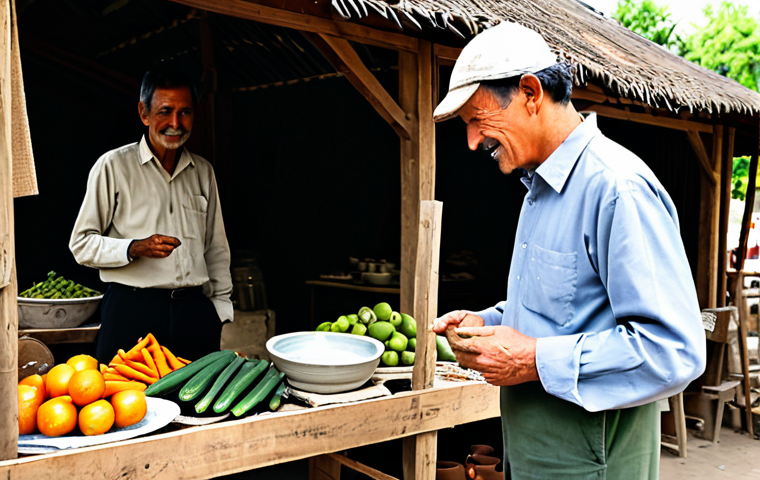
From my vantage point, having navigated countless rural landscapes and engaged with various tourism professionals, I’ve witnessed a profound transformation in what it means to be a rural tourism guide. It’s no longer just about leading groups from one scenic spot to another, pointing out landmarks. My personal experience tells me that today’s successful guide is a multi-faceted individual – a storyteller, an educator, a conservationist, and often, a small business entrepreneur rolled into one. I remember a particularly impactful trip through the Appalachian foothills where our guide, Sarah, didn’t just show us a waterfall; she shared personal anecdotes about her family’s generations-long connection to the land, explained the indigenous flora in detail, and even taught us how to identify local bird calls. That kind of deep, personal engagement is what truly elevates an experience. It resonated with me long after the trip ended, creating a lasting memory that a simple picture could never capture. The shift is palpable: travelers are seeking deeper connections, authentic narratives, and a sense of shared purpose, moving far beyond superficial sightseeing. It means we, as guides, are constantly learning, adapting, and enriching our own understanding of the places we share. Honestly, the most rewarding part for me has been seeing the light of understanding in visitors’ eyes when they truly connect with a place’s spirit, not just its scenery.
1. From Tour Leader to Experience Curator
The transition from a simple tour leader to a sophisticated experience curator is, in my professional opinion, the most significant shift. When I started in this field, the focus was often on itinerary adherence and factual dissemination. Now, what truly sets a guide apart is their ability to weave a narrative, to create a holistic journey that touches all senses and emotions. I’ve often felt that my role isn’t just to show, but to evoke. This means understanding the emotional landscape of my guests, anticipating their curiosities, and crafting moments that feel organic and deeply personal. It’s about designing an experience that allows visitors to *feel* the history, *taste* the local flavors, and *hear* the untold stories. For instance, instead of merely visiting a farm, I’ve designed tours where guests actively participate in harvesting, learn traditional cooking methods, and share a meal with the farming family. It’s messy, sometimes unpredictable, but consistently more rewarding and memorable than a passive observation. The feedback I’ve received consistently highlights these participatory elements as the peak experiences of their trips, reinforcing my belief that authentic immersion is key.
2. The Imperative of Local Expertise and Storytelling
True local expertise isn’t just about knowing facts; it’s about intimately understanding the pulse of a place, its hidden gems, and its untold stories. This is where my personal passion truly comes alive. I find immense joy in uncovering the obscure, in meeting the unsung heroes of a community, and in sharing narratives that aren’t found in guidebooks. A genuine rural tourism guide acts as a living bridge between visitors and the local community. They possess an encyclopedic knowledge of local folklore, traditions, and the nuanced social fabric. It’s about knowing the best time to see the mist rise over the valley, where to find the farmer who still uses traditional methods, or the local artisan whose craft is slowly disappearing. This deep knowledge allows for spontaneous, enriching detours and conversations that are impossible to script. I recall a time when an impromptu stop at a local pottery studio, suggested by our guide, turned out to be the highlight for many, fostering a genuine connection with the artist and a unique souvenir. It’s these layers of authentic, unscripted interaction that elevate a trip from good to utterly unforgettable.
Crafting Authentic & Immersive Experiences
In my journey as a rural tourism advocate, I’ve consistently observed that the real magic happens when an experience feels truly authentic, not staged. It’s a delicate balance to strike, but one that rural tourism guides are uniquely positioned to master. The goal, from my perspective, is to move beyond passive observation and encourage active participation, allowing visitors to step into the local way of life. This could mean anything from helping out on a farm for an hour, learning a traditional craft from a local artisan, or simply sharing a meal prepared with ingredients sourced from within a five-mile radius. I remember one particular group that was initially hesitant about getting their hands dirty at a small vineyard. But once they started pruning vines and tasting fresh grapes right off the bush, their initial reservations dissolved into pure joy and genuine curiosity. The laughter, the questions, the shared sense of accomplishment – these are the moments that forge real connections and create lasting memories. It’s about creating an environment where visitors feel like welcomed guests, not just fleeting tourists, and where their engagement directly supports the local economy and culture. This is the heart of what I strive for in every experience I help to curate.
1. Designing Participatory Activities
Designing truly participatory activities goes far beyond a mere suggestion; it requires thoughtful planning, local partnerships, and a keen understanding of what will genuinely engage visitors. My approach has always been to seek out experiences where visitors can contribute, learn, and interact directly. This isn’t about making them work, but about offering a chance to truly understand and appreciate the effort behind local products or traditions. Imagine learning to bake bread in a traditional wood-fired oven with a local baker, or spending an afternoon learning to shear sheep from a third-generation farmer. These aren’t just activities; they are windows into a way of life, fostering empathy and appreciation. I’ve found that when people get involved, their senses are heightened, and their memories become more vivid. They recall the smell of the fresh bread, the feel of the sheep’s wool, the sound of the farmer’s laughter. These are the sensory details that transform a good trip into an unforgettable story they’ll tell for years, proving that engagement is paramount to authentic rural immersion.
2. Showcasing Local Gastronomy and Craftsmanship
For me, showcasing local gastronomy and craftsmanship is one of the most delicious and tangible ways to connect visitors with a region’s soul. It’s about celebrating the flavors, the textures, and the skilled hands that shape a community’s identity. I’ve personally guided countless groups through farmers’ markets, connecting them directly with the growers and producers, allowing them to taste heirloom varietals of fruits and vegetables that you simply can’t find in urban supermarkets. Beyond just eating, it’s about understanding the journey from farm to fork. This also extends to traditional crafts: visiting a local weaver, a potter, or a woodcarver doesn’t just offer a chance to purchase a unique souvenir; it provides an intimate glimpse into generations of skill and dedication. I love watching visitors’ faces light up as they witness the intricate processes, hearing the stories behind each piece. These experiences not only support local artisans and small businesses but also create a profound appreciation for the cultural heritage embedded in every bite and every handmade item. It’s a truly visceral and deeply satisfying part of what I do.
The Heart of Sustainability: Guides as Stewards of the Land
The role of a rural tourism guide extends far beyond mere hospitality; it encompasses a profound responsibility towards the environment and the local communities we operate within. I’ve come to understand that being a guide means being a steward of the land, an advocate for sustainable practices, and an educator on responsible tourism. It’s not enough to simply enjoy the beauty of a natural landscape; we must actively work to preserve it, ensuring that our visits leave no trace and, ideally, contribute positively to the area’s ecological health. My personal commitment to this principle stems from seeing firsthand the delicate balance between tourism development and environmental preservation. I’ve learned that a truly impactful guide doesn’t just point out wildlife; they explain its habitat, discuss conservation efforts, and encourage visitors to adopt responsible behaviors. It’s about fostering a deeper respect and understanding, inspiring action rather than passive consumption. This holistic approach ensures that the rural charm that attracts visitors today will continue to thrive for future generations, and this commitment is something I try to embed into every single tour I lead.
1. Promoting Low-Impact Tourism Practices
Promoting low-impact tourism is a cornerstone of responsible guiding, and it’s a principle I adhere to rigorously. It’s about minimizing our footprint, respecting fragile ecosystems, and educating visitors on how to be mindful travelers. This might involve advocating for trails over off-roading, supporting local businesses that use sustainable practices, or simply encouraging the proper disposal of waste. From my own experience, leading by example is crucial. I always carry reusable water bottles, explain the importance of staying on marked paths, and gently remind guests about leaving nature as we found it. I’ve found that most people are eager to do the right thing when given clear guidance and understand the reasoning behind it. It’s a continuous conversation, making sure everyone understands that the beauty they’re enjoying is fragile and requires collective effort to protect. My most rewarding moments are when guests actively participate in a small clean-up, or express renewed commitment to environmental responsibility after a tour, realizing the direct impact of their choices.
2. Supporting Local Conservation Efforts
Beyond individual actions, actively supporting local conservation efforts is a vital responsibility for any rural tourism guide. This means forging partnerships with local environmental organizations, directing visitors to projects they can contribute to, and sometimes even organizing hands-on conservation activities as part of the tour. I’ve personally collaborated with local land trusts and wildlife sanctuaries, incorporating visits that highlight their work and allow guests to see the direct impact of conservation. For example, a significant portion of my tour fees might be directed towards a local wildlife rehabilitation center, or I might arrange for guests to participate in a tree-planting initiative. It’s about building a symbiotic relationship where tourism benefits the environment, not degrades it. I believe it’s essential to show visitors that their presence can be a force for good, directly contributing to the well-being of the natural world they’ve come to experience. It’s deeply satisfying to see tour participants become invested, realizing their holiday isn’t just about leisure but also about meaningful contribution.
Building Connections: Beyond the Transaction
What truly differentiates a memorable rural tourism experience from a forgettable one, in my seasoned view, is the depth of human connection forged. It’s about moving beyond a simple transactional exchange to create genuine rapport between visitors, locals, and the guide themselves. I’ve often felt that my role is less about being a leader and more about being a facilitator of these connections. This means fostering an environment where conversations flow freely, where stories are shared, and where genuine curiosity about different cultures and ways of life is encouraged. I recall a delightful instance where a group of city-dwellers, initially reserved, found themselves laughing heartily with a local farmer over coffee and homemade pie, discussing the challenges of modern agriculture. That spontaneous interaction, facilitated by me, broke down barriers and created a shared moment of humanity that transcended their brief visit. It’s in these unplanned, organic interactions that the true magic of rural tourism lies, offering insights and warmth that no brochure could ever convey. My ultimate goal is for visitors to leave not just with souvenirs, but with stories of real people and genuine friendships, making their journey profoundly enriching.
1. Fostering Guest-Local Interaction
Fostering genuine guest-local interaction is a cornerstone of my approach. It’s not about forced encounters, but about creating natural opportunities for connection. I deliberately seek out opportunities for my guests to meet and engage with local residents – be it a casual chat with a shopkeeper, a brief conversation with a shepherd, or a more structured visit to a community center. I believe that these interactions are the most potent ingredients for authentic cultural immersion. I’ve personally seen how a simple shared smile or a few words exchanged over a local craft can bridge vast cultural differences. For me, success isn’t measured by how many sites we cover, but by the quality of these human connections. It is incredibly rewarding to witness a visitor, initially shy, light up as they share a laugh with a local, discovering common ground despite different backgrounds. These moments are the true gems of rural tourism, transforming a scenic trip into a deeply personal and enriching journey. It’s a testament to the power of human connection.
2. The Art of Personalizing the Journey
The art of personalizing the journey is a skill I’ve honed over years, recognizing that every traveler, every group, brings unique interests and expectations. It’s about listening intently, observing subtle cues, and subtly adjusting the experience to resonate deeply with each individual. I often engage in pre-trip conversations to understand specific interests – perhaps a passion for birdwatching, an interest in local history, or a desire for quiet reflection. Based on these insights, I might weave in an unscheduled stop at a specific antique shop, or spend extra time at a historical marker that holds particular relevance. I remember a family where the youngest child was fascinated by insects; I spontaneously brought along a magnifying glass and pointed out various beetles and butterflies, turning a simple walk into an exciting bug hunt for him. These small, thoughtful adjustments, born from genuine care and observation, transform a standard tour into a bespoke adventure that feels uniquely tailored. It’s what makes visitors feel truly seen and valued, ensuring their experience is not just good, but deeply meaningful to them.
Embracing Technology: Enhancing the Guide’s Toolkit
While the essence of rural tourism hinges on authentic, human connection, I’ve found that technology, far from being a detractor, can be a powerful enhancer in a guide’s toolkit. My perspective is that smart integration of digital tools can significantly improve efficiency, enrich the interpretive experience, and even enhance safety, without sacrificing the personal touch. It’s about leveraging technology to free up time for deeper interactions, rather than letting it replace them. For instance, using mapping apps for real-time navigation allows me to focus on telling stories rather than fumbling with paper maps. Similarly, digital presentation tools can bring historical photos or ecological data to life in a way that mere verbal description cannot. I’ve personally experimented with various apps that help identify flora and fauna, or translate phrases, finding them invaluable for augmenting the visitor experience. The trick, I’ve learned, is to use technology judiciously and seamlessly, ensuring it complements, rather than dominates, the genuine human connection that remains at the core of rural guiding. It’s all about making the guide’s job smoother so they can concentrate on the truly important, human-centric elements of the tour.
1. Digital Tools for Enhanced Storytelling and Navigation
Digital tools have revolutionized how I approach storytelling and navigation, allowing me to provide a richer, more dynamic experience. Gone are the days when I relied solely on verbal descriptions; now, I can seamlessly integrate historical photographs, short video clips of local traditions, or even audio recordings of oral histories using a tablet or smartphone. This multi-sensory approach brings narratives to life in a much more vivid way. For example, when discussing a historic homestead, I can instantly pull up an old photo of the family who lived there, making the story feel more immediate and real. Furthermore, advanced GPS and mapping applications are indispensable for navigation, especially in remote rural areas with unreliable signal. They allow me to pinpoint exact locations of interest, identify potential hazards, and provide real-time updates on our route, ensuring both efficiency and safety. This frees me up to engage more deeply with my guests, focusing on the cultural context and personal anecdotes rather than getting lost. It’s about leveraging precision to enhance presence, making every moment count.
2. Connecting with Digital Nomads and Remote Workers
A fascinating trend I’ve observed and actively engaged with is the rise of digital nomads and remote workers seeking rural retreats. These individuals often crave a blend of natural beauty, authentic local experiences, and reliable connectivity. As a guide, understanding their unique needs is crucial. I’ve found that offering tours that integrate opportunities for remote work, such as access to co-working spaces in quaint village settings or spots with strong Wi-Fi signals amidst stunning landscapes, can be a major draw. It’s about creating an itinerary that allows them to seamlessly blend work with exploration, proving that you don’t have to choose between a thriving career and an enriching rural escape. My experience suggests that these travelers are often keen to connect with local entrepreneurs and learn about sustainable living, offering a unique niche for guides who can cater to both their professional and leisure interests. It’s a truly exciting frontier where traditional tourism meets modern work culture, creating a dynamic new market for rural destinations, and I’ve found it incredibly rewarding to help bridge that gap.
The Economic Impact: Guides as Local Catalysts
In my opinion, rural tourism guides are far more than just facilitators of experiences; they are vital economic catalysts, playing a direct and significant role in boosting local economies. Through their daily interactions and recommendations, guides can funnel much-needed revenue directly into the hands of local businesses, farmers, artisans, and service providers. I’ve personally made it a point to prioritize collaborations with small, independently owned establishments – the quaint cafe that bakes its own pastries, the family-run farm that offers fresh produce, or the artisan who handcrafts unique souvenirs. This isn’t just about being ethical; it’s about creating an authentic, localized experience that benefits the entire community. I’ve seen firsthand how a guide’s recommendation can lead to a surge in business for a struggling local shop, or how a visit to a remote farm can provide crucial income for a family. It’s immensely satisfying to know that my work directly contributes to the financial well-being of the very communities whose stories I share. This ripple effect of responsible tourism is a powerful force for sustainable development, ensuring that tourism benefits everyone involved, not just external operators.
| Aspect | Traditional Rural Guide | Modern Rural Tourism Guide |
|---|---|---|
| Primary Focus | Sightseeing, factual information, schedule adherence | Experience curation, emotional connection, immersive engagement |
| Relationship with Locals | Often limited interaction, transactional | Collaborative partnerships, community integration, active support |
| Technology Use | Minimal, mostly for basic communication | Strategic integration for navigation, storytelling, and safety |
| Environmental Ethos | Passive appreciation, basic “leave no trace” | Active stewardship, conservation advocacy, low-impact education |
| Economic Impact | Indirect, often through large operators | Direct funneling of revenue to local small businesses, artisans, farmers |
| Desired Visitor Outcome | Enjoyment, good photos, checklist completion | Profound connection, lasting memories, inspired advocacy for the region |
1. Directing Visitors to Local Businesses
Directing visitors to local businesses is not just a suggestion I make; it’s an ingrained part of my guiding philosophy. I view myself as a vital link between the curious traveler and the hardworking local entrepreneurs who form the backbone of rural economies. This means consciously choosing local eateries for lunch breaks, recommending specific artisans for souvenir purchases, and highlighting small, family-owned accommodations. I’ve learned that a simple, enthusiastic recommendation from a trusted guide can significantly influence a visitor’s spending habits. I remember one tour where, after visiting a small, family-run cheese farm, nearly every participant bought products directly from them, providing a tangible boost to their income. It’s incredibly rewarding to see the direct positive impact of these choices – not just on the businesses themselves, but on the morale and sustainability of the entire community. This deliberate support ensures that tourism dollars circulate locally, strengthening the economic fabric of the rural areas we cherish and help to promote.
2. Creating Opportunities for Local Employment and Skill Development
Beyond direct spending, effective rural tourism also creates opportunities for local employment and skill development, a facet I personally find incredibly rewarding. As guides, we can actively seek out partnerships that empower local residents, offering them roles within the tourism ecosystem. This might involve training local community members to assist with tours, encouraging them to develop their own small businesses related to catering or craft production for visitors, or even collaborating on educational workshops. I’ve personally initiated programs to train local youth in basic guiding skills, focusing on their unique knowledge of the area and culture. This not only provides them with valuable experience and potential income but also enhances the authenticity of the visitor experience, as they interact with genuine local voices. It’s a powerful way to ensure that tourism acts as a sustainable development tool, providing pathways for economic growth and fostering a sense of pride within the community, all while enriching the visitor’s journey with truly local perspectives.
Navigating Challenges and Ensuring Trust
My journey as a rural tourism guide, while incredibly fulfilling, hasn’t been without its unique set of challenges. From unpredictable weather and navigating remote terrains to managing diverse group dynamics and unforeseen local events, the role demands resilience, adaptability, and a strong sense of responsibility. However, what truly defines a successful guide, in my experience, is their ability to navigate these challenges with grace and, crucially, to consistently build and maintain the trust of their visitors. Trust is the bedrock of any meaningful experience. It’s earned not just through expertise, but through transparency, genuine care, and a consistent commitment to safety and well-being. I’ve learned that openly communicating potential difficulties, being prepared for contingencies, and showing genuine concern for each individual’s comfort are paramount. There was one memorable occasion when an unexpected storm rolled in, forcing a sudden change of plans. By calmly explaining the situation, offering alternatives, and ensuring everyone’s safety, I managed to turn a potential disaster into an adventure, earning profound appreciation from the group. It’s these moments, when faced with adversity, that the strength of a guide’s character and their commitment to their guests truly shine through, reinforcing the trust that makes a journey truly unforgettable.
1. Prioritizing Safety and Well-being
Prioritizing safety and well-being is, without a doubt, my absolute top concern. When you’re leading people into potentially unfamiliar or remote rural environments, their safety rests squarely on your shoulders. My approach always begins with meticulous planning: thoroughly researching routes, understanding local weather patterns, and knowing emergency protocols. I also carry comprehensive first-aid kits and am trained in wilderness first aid. During tours, I’m constantly assessing the environment and the group’s comfort levels, making adjustments as needed. I remember a time when a guest started showing signs of heat exhaustion on a particularly warm day. My immediate response was to find shade, provide hydration, and assess their condition, altering the rest of the day’s itinerary to ensure their full recovery. It’s about being proactive, vigilant, and ready to respond calmly and effectively to any situation, big or small. Guests must feel secure and cared for at all times, and instilling that confidence is a fundamental part of the trust equation. It’s a responsibility I take incredibly seriously, as it forms the very foundation of a positive and memorable experience.
2. Building Credibility and Authority
Building credibility and authority as a rural tourism guide is an ongoing process that goes beyond simply having extensive knowledge; it involves consistently demonstrating genuine expertise, reliability, and an unwavering passion for the region. For me, this means continuous learning – staying updated on local ecology, history, and community developments, and even learning basic phrases in local dialects where applicable. It’s about being able to answer intricate questions with confidence, sharing obscure anecdotes, and anticipating visitor interests. I find that when I can seamlessly weave deep historical context with current ecological insights, for example, it immediately elevates the experience. Furthermore, ethical conduct and transparent communication are crucial. I always strive to manage expectations clearly, be punctual, and follow through on promises. When visitors see that I am truly dedicated, knowledgeable, and reliable, their trust in my authority grows exponentially. It’s a deeply satisfying feeling to know that my reputation is built on authentic experience and a genuine commitment to providing the best possible journey, leaving guests feeling enriched and inspired.
A Concluding Thought
As I reflect on the incredible journey of rural tourism guiding, it’s clear that this role is continually evolving, demanding more than just knowledge of a map or a list of facts. It’s about a heartfelt commitment to curating authentic experiences, fostering deep connections, and advocating for the very landscapes and communities we cherish. The satisfaction derived from seeing visitors truly engage, learn, and fall in love with a place, often in ways they never expected, is immeasurable. This profession, for me, is a passionate pursuit of shared discovery, building bridges between travelers and the vibrant spirit of rural life, ensuring its stories continue to be told and its beauty preserved for generations to come. It’s a privilege to be a part of this unfolding narrative.
Useful Information
1. Embrace Authenticity: Always prioritize genuine interactions and experiences over manufactured ones. Travelers crave real connections with local people, food, and culture.
2. Leverage Technology Thoughtfully: Use digital tools for enhanced navigation, storytelling, and safety, but ensure they complement, rather than detract from, the human element.
3. Champion Sustainability: Integrate low-impact practices and support local conservation efforts. Educate guests on responsible tourism to preserve destinations for the future.
4. Personalize Every Journey: Listen to your guests’ interests and tailor elements of the tour to create a unique and deeply resonant experience for each individual or group.
5. Be a Local Economic Catalyst: Consciously direct visitors to small, local businesses—artisans, farmers, eateries—to ensure tourism dollars directly benefit the community.
Key Takeaways
The modern rural tourism guide has transformed from a mere leader to a multifaceted experience curator, deeply committed to authenticity, sustainability, and human connection. This evolution involves weaving rich narratives, fostering local interaction, and strategically using technology to enhance the journey. Guides act as vital economic catalysts, channeling revenue to local communities, and as dedicated stewards, promoting environmental preservation. Trust, built on expertise, safety, and genuine care, remains the bedrock of creating truly unforgettable and impactful rural tourism adventures.
Frequently Asked Questions (FAQ) 📖
Q: Given the dramatic shift in what travelers seek, what specific qualities or skills do you believe make a rural tourism guide truly indispensable today?
A: Oh, this is something I’ve pondered deeply after so many trips where the guide made or broke the experience. Honestly, it’s less about memorizing facts and more about being a truly passionate storyteller and a genuine connector.
I’ve found the truly indispensable guides aren’t just reciting a script; they’re sharing a piece of their soul and their community. They possess an almost palpable love for their land, its history, and its people.
For instance, I remember a trip to the Scottish Highlands where our guide, a local shepherd, didn’t just point out landmarks; he wove tales of his ancestors, explained the nuances of the landscape that informed his life, and even taught us a few words of Gaelic.
That wasn’t just a tour; it was an invitation into his world. The skills that stand out are empathy, a knack for improvisation when things don’t go to plan (and they never perfectly do in the countryside!), and a deep, authentic local knowledge that goes far beyond what you can Google.
They make you feel like you’re not just a tourist, but a temporary local, and that’s priceless.
Q: You mentioned travelers are craving more than just sightseeing. Can you elaborate on what these ‘authentic, immersive experiences’ truly look like in practice, from your perspective?
A: From my own adventures, “authentic and immersive” means getting your hands dirty, literally and figuratively, and feeling truly part of something, not just observing it.
It’s about peeling back the layers of a place. For example, instead of just seeing a farm, it’s about spending a morning helping with chores, perhaps collecting eggs, learning to milk a goat, or understanding the regenerative farming practices directly from the farmer.
I once participated in a wild foraging walk in the Catskills where we learned to identify edible plants and then used them to prepare a simple meal right there in nature.
That wasn’t just a pleasant walk; it was a sensory, educational, and deeply satisfying experience. Or imagine a “digital detox” where your phone is locked away, and your days are spent learning traditional crafts from a local artisan, maybe weaving or pottery, completely disconnected from the usual modern distractions.
These experiences aren’t polished for tourists; they’re real slices of rural life, offered with genuine hospitality. They leave you with a sense of accomplishment and a story that feels uniquely yours.
Q: With all the talk of
A: I and digital tools, why do you feel the ‘human touch’ remains so utterly irreplaceable in the future of rural tourism, especially concerning that ‘profound connection’ you mentioned?
A3: That’s the million-dollar question, isn’t it? And my answer is unequivocally that the human touch is everything. While AI can brilliantly streamline logistics – booking, navigation, even providing information – it simply cannot replicate the spontaneous, emotional, and deeply personal connections that make a rural getaway truly transformative.
Think about it: an AI can tell you the history of a landmark, but it can’t share a personal anecdote about growing up next to it, or show you a hidden, unlisted path only locals know, or instinctively sense when you need a quiet moment of reflection versus an energetic story.
That ‘profound connection’ comes from shared laughter, from the unexpected wisdom offered by someone who has lived on that land for decades, from the empathy in a guide’s eyes when you’re deeply moved by a view.
It’s the nuance, the shared human experience, the spontaneous detour to meet a local character, or that unexpected cup of tea offered at a farmhouse. AI lacks heart, intuition, and the ability to truly feel and adapt to the subtle dynamics of human interaction.
For rural tourism to foster genuine connection and leave lasting memories, that irreplaceable human presence, guiding with passion and authenticity, will always be its beating heart.
📚 References
Wikipedia Encyclopedia
구글 검색 결과
구글 검색 결과
구글 검색 결과
구글 검색 결과
구글 검색 결과
